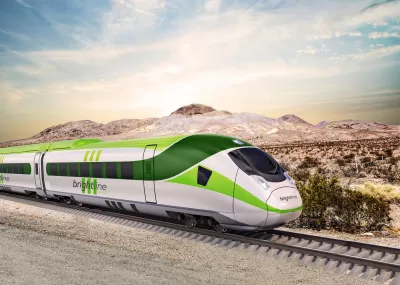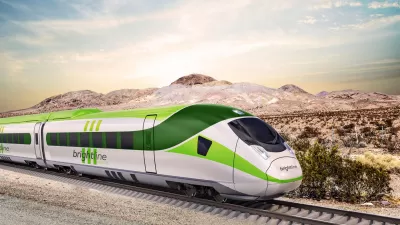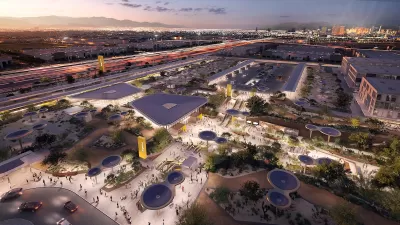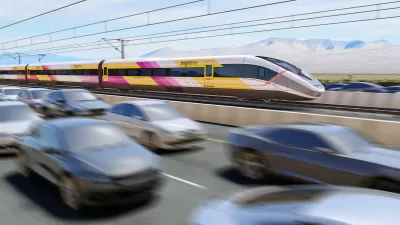The privately funded train would shuttle passengers between Los Angeles and Las Vegas in half the time it takes to drive and could take 3 million vehicles off the road.

A high speed rail connection between Los Angeles and Las Vegas could break ground next year, promising to cut the trip between Southern California and Vegas to just over two hours. As Dan Zukowski writes in Smart Cities Dive,the $8 billion, privately funded project would operate high speed trains along the Interstate 15 corridor, primarily using the highway median.
According to Zukowski, “A total of $1 billion in private activity bonds has been approved by the U.S. Department of Transportation for Brightline West, with the actual borrowing to be done by the states of California and Nevada. Brightline West may soon ask California to issue $200 million in private activity bonds, Bloomberg News reported this week.”
The operator, Brightline, already runs passenger trains in Florida. “Brightline acquired a station site along Las Vegas Boulevard and reached an agreement with authorities in California to purchase a 5-acre site at the Rancho Cucamonga Station,” which would connect to regional transit options. According to Brightline, the train could remove 3 million vehicles from California and Nevada roads each year.
FULL STORY: High-speed rail line from LA to Las Vegas could begin construction in 2023

Manufactured Crisis: Losing the Nation’s Largest Source of Unsubsidized Affordable Housing
Manufactured housing communities have long been an affordable housing option for millions of people living in the U.S., but that affordability is disappearing rapidly. How did we get here?

Americans May Be Stuck — But Why?
Americans are moving a lot less than they once did, and that is a problem. While Yoni Applebaum, in his highly-publicized article Stuck, gets the reasons badly wrong, it's still important to ask: why are we moving so much less than before?

Using Old Oil and Gas Wells for Green Energy Storage
Penn State researchers have found that repurposing abandoned oil and gas wells for geothermal-assisted compressed-air energy storage can boost efficiency, reduce environmental risks, and support clean energy and job transitions.

Updating LA’s Tree Rules Could Bring More Shade to Underserved Neighborhoods
A new USC study finds that relaxing Los Angeles’ outdated tree planting guidelines could significantly expand urban tree canopy and reduce shade disparities in lower-income neighborhoods, though infrastructure investments are also needed.

California's Canal Solar Projects Aim to Conserve Resources and Expand Clean Energy
California’s Project Nexus has begun generating electricity from solar panels installed over irrigation canals, with researchers and state agencies exploring statewide expansion to conserve water and boost clean energy production.

HHS Staff Cuts Gut Energy Assistance Program
The full staff of a federal program that distributes heating and cooling assistance for low-income families was laid off, jeopardizing the program’s operations.
Urban Design for Planners 1: Software Tools
This six-course series explores essential urban design concepts using open source software and equips planners with the tools they need to participate fully in the urban design process.
Planning for Universal Design
Learn the tools for implementing Universal Design in planning regulations.
Heyer Gruel & Associates PA
City of Moreno Valley
Institute for Housing and Urban Development Studies (IHS)
City of Grandview
Harvard GSD Executive Education
Salt Lake City
NYU Wagner Graduate School of Public Service
City of Cambridge, Maryland





























